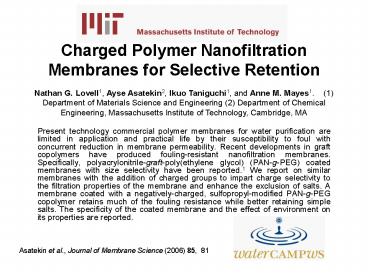Charged Polymer Nanofiltration Membranes for Selective Retention - PowerPoint PPT Presentation
1 / 12
Title:
Charged Polymer Nanofiltration Membranes for Selective Retention
Description:
1 g/L BSA solution. Membrane Limitations ... 1 g/L BSA in PBS for fouling. 1Asatekin et al., Journal of Membrane Science (2006) 85, 81 } ... – PowerPoint PPT presentation
Number of Views:636
Avg rating:3.0/5.0
Title: Charged Polymer Nanofiltration Membranes for Selective Retention
1
Charged Polymer Nanofiltration Membranes for
Selective Retention
Nathan G. Lovell1, Ayse Asatekin2, Ikuo
Taniguchi1, and Anne M. Mayes1. (1) Department
of Materials Science and Engineering (2)
Department of Chemical Engineering, Massachusetts
Institute of Technology, Cambridge, MA
- Present technology commercial polymer membranes
for water purification are limited in application
and practical life by their susceptibility to
foul with concurrent reduction in membrane
permeability. Recent developments in graft
copolymers have produced fouling-resistant
nanofiltration membranes. Specifically,
polyacrylonitrile-graft-poly(ethylene glycol)
(PAN-g-PEG) coated membranes with size
selectivity have been reported.1 We report on
similar membranes with the addition of charged
groups to impart charge selectivity to the
filtration properties of the membrane and enhance
the exclusion of salts. A membrane coated with a
negatively-charged, sulfopropyl-modified
PAN-g-PEG copolymer retains much of the fouling
resistance while better retaining simple salts.
The specificity of the coated membrane and the
effect of environment on its properties are
reported.
Asatekin et al., Journal of Membrane Science
(2006) 85, 81
2
Membrane Limitations
- Problem fouling (macromolecule adsorption onto
membranes) - ? flux
- ? membrane life
- ? energy use
Humic acid fouled membrane, 3.5x104x SEM
(Professional Water Technologies, Inc.)
80 irreversible permeability loss
(Commercial PAN UF membrane)
3
Amphiphilic Graft Copolymer Thin Film Composite
NF Membranes
- Amphiphilic graft copolymers
- Simple coating for thin selective layer
- Microphase separate into bicontinuous network
- Form hydrophilic nanochannels
- Nanochannels allow passage of water and small
molecules1
Hydrophilic PEG nanochannel
Hydrophobic PAN glassy matrix
TEM of PAN-g-PEG section by Elsa Olivetti
1 Akthakul et al., Macromolecules (2004) 37, 7663
4
Amphiphilic Graft Copolymer TFC vs. Commercial
Membranes
- Amphiphilic graft copolymer TFC NF membranes
have - 300 the permeability of commercial membranes
- No permanent protein/ polysaccharide fouling
(commercial PAN UF membrane fouled 80)
- Size cut-off 0.9 nm (by dye exclusion)
- No charge?low salt retention
- Glassy, hydrophobic matrix, often
polyacrylonitrile (PAN) - Hydrophobic, protein resistant side chain
poly(ethylene glycol) (PEG)
SEM of a TFC membrane cross section with
PAN-g-PEG selective layer on a PAN UF base
PAN-g-PEG
Selective layer (lt2 µm)
Asatekin et al., Patent application. MIT Case
No.12171, filed 04/11/06
5
Charged Amphiphilic Graft Copolymer Synthesis
Characterization
- Free radical synthesis of P(AN-r-SPA)-g-PEG
- acrylonitrile
- poly(ethylene glycol) monomethyl ether acrylate
- 3-sulfopropyl acrylate potassium salt (SAPS)
- Typical properties of P(AN-r-SPA)-g-PEG
- Mw 5M, Mw/Mn gt 10
- (DMF GPC, PS standards)
- Composition
- 0.5-1.5 wt SAPS
- 30-40 wt PEG (by NMR)
DMSO NMR
6
TFC Membrane Coating Testing
- Coating
- 7 DMF solution P(AN-r-SPA)-g-PEG
- PAN base membrane (SEPRO PAN400)
- 40 µm doctor blade height (Testing Machines,
Inc.) - Coagulation
- transfer to isopropanol bath
- Permeability and fouling testing1
- dead-end mode
- 50 psi
- 1 g/L BSA in PBS for fouling
coat base membrane
Diagram Thin Film Composite membrane
1Asatekin et al., Journal of Membrane Science
(2006) 85, 81
7
Permeability and Retention vs. Salt Concentration
8
PEG/Water Miscibility
- Change in permeability/retention may be due to
change in morphology - PEG has LCST in water1
- Miscibility attributed to H-bonding or
electrostatic interactions2 - Potential disruptions
- ionic strength
- salt size and valence
- (eg. effect of KCl gt effect of NaCl3)
- pressure
- temperature
- Salted out PEG collapses, enlarging nanochannels
? flux ? retention ? - Osmotic pressure in low salt/ high retention
solutions ? flux
0.3 M NaCl
0.0 M NaCl
Phase diagram of PEG/water showing LCST behavior
and NaCl influence1
1Saeki et al., Polymer 1977, 18, 1027 2Ashbaugh
et al., Ind. Eng. Chem. Res. 2006, 45,
5531 3Taboada et al., J. Chem. Eng. Data 2005,
50, 264
9
Permeability and Retention vs. Species
Under equal ionic strength conditions
- Divalent calcium and magnesium
- ? chloride retention
- ? flux
- ? retention of larger, divalent sulfate ion
Solutions w/ equivalent ionic strength to 200 PPM
NaCl (0.0034)
10
Fouling (Resistance)
- 86 permeability recovered with water rinse
- By comparison, PAN UF base membrane fouled 80
irreversibly1
1Asatekin et al., Journal of Membrane Science
(2006) 85, 81
11
Conclusions
- Charged amphiphilic graft copolymer
P(AN-r-SPA)-g-PEG synthesized via free radical
polymerization - TFC NF membranes produced by coating PAN UF base
membrane with charged polymer - ? salt ? NF membrane salt retention ?
permeability ? - Salt impact on membrane is species
concentration dependent may be due to collapse
of PEG within nanochannels - Divalent Ca2 ? membrane permeability, ?
retention vs. Na - Larger, divalent SO42- is better retained than
Cl- - Amphiphilic graft copolymer TFC membranes
charged group ? - improved salt retention
- good fouling resistance
- higher charge content should improve retention
12
Acknowledgements
- Funding
- WaterCAMPWS NSF Agreement CTS-0120978
- CMSE Shared Experimental Facilities
- MRSEC Program of NSF Award DMR-02-13282
- DCIF NMR facility
- NIH grant 1S10RR13886-01
- Mayes group
- Elsa Olivetti (TEM)
- Professor Michael Rubner































